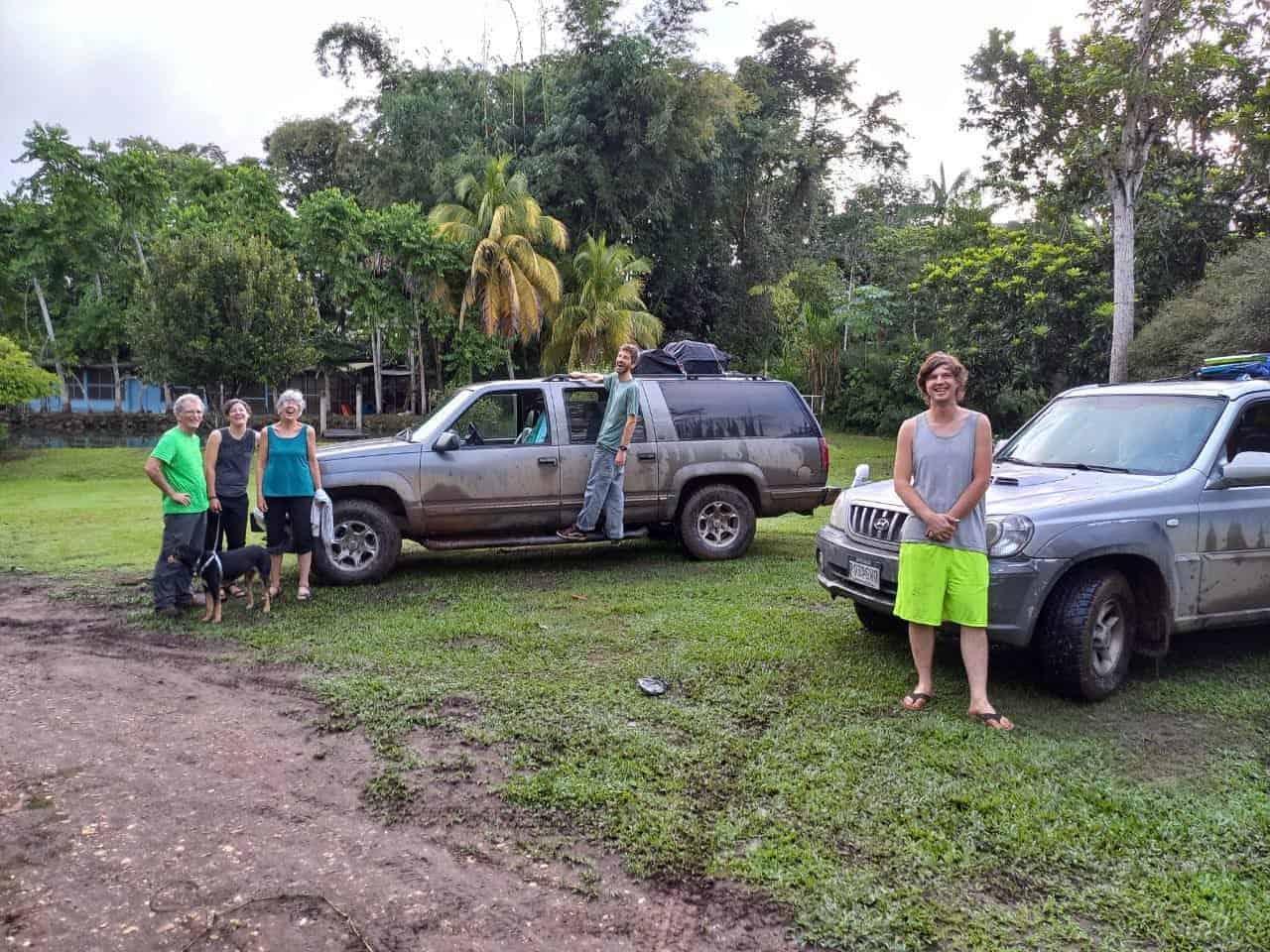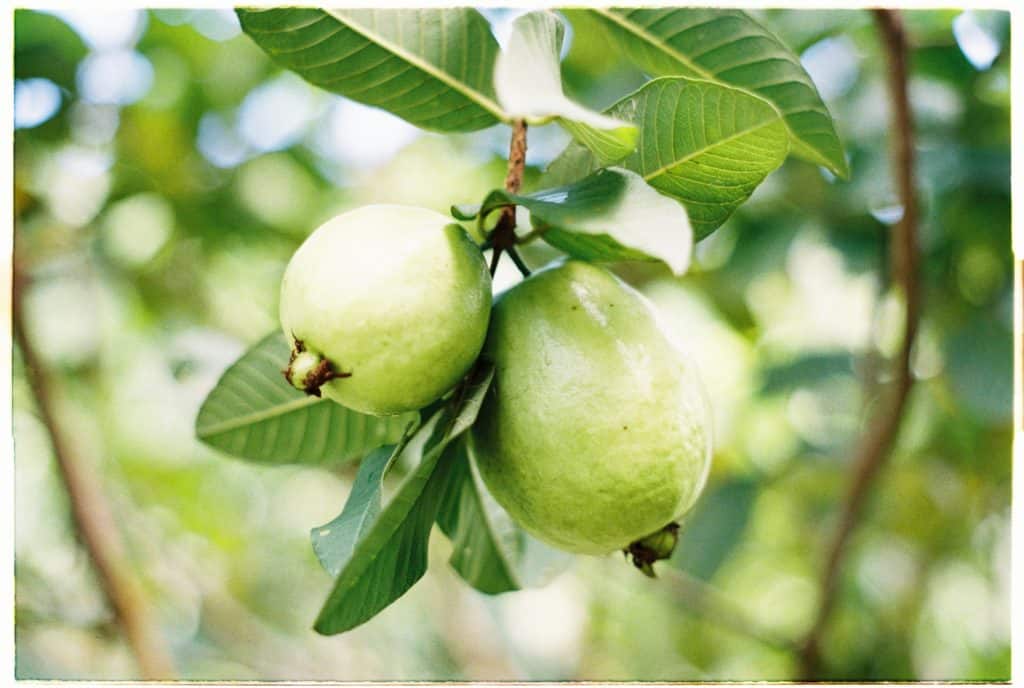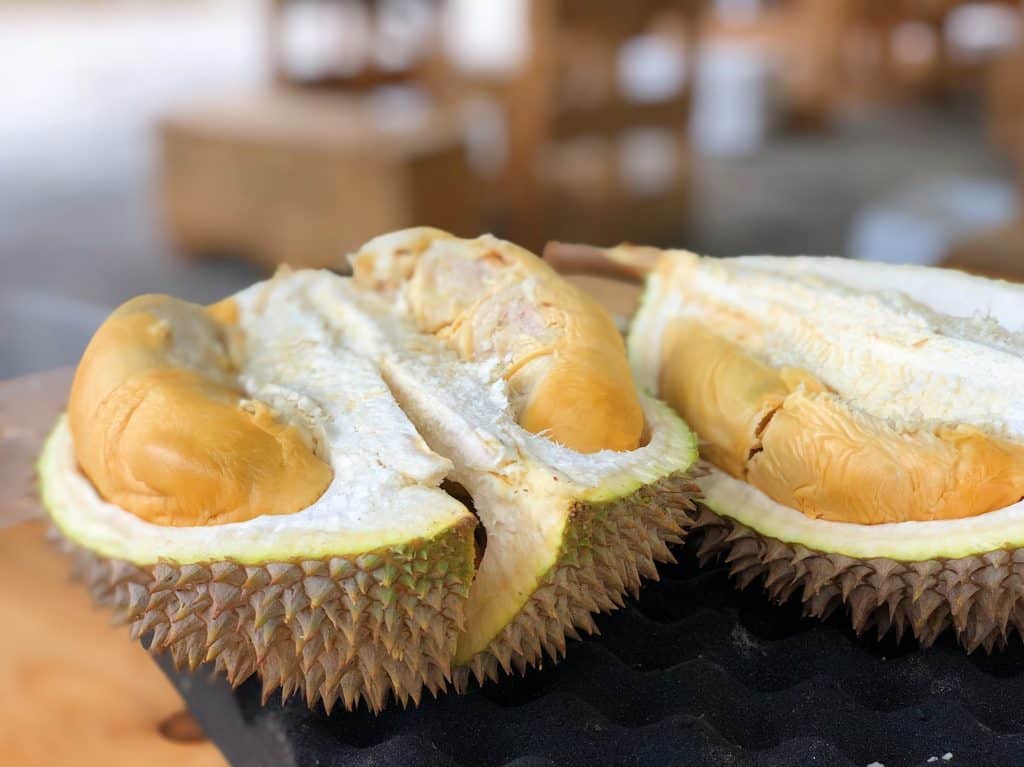Vivero Frutas del Mundo Izabal – Exotic Fruit Nursery
If you’re looking for something unusual to do in Izabal Guatemala, check out Vivero Frutas del Mundo! This exotic fruit farm and nursery is a great place to stop. The nursery offers a variety of tours, farm-to-table dining, taste-testing, and more.
Table of Contents
Why go to Vivero Frutas del Mundo
Tours Available at Frutas del Mundo
Farm to Table Restaurant
Exotic Trees Varieties for Sale at Vivero Frutas del Mundo
How to Get to Vivero Frutas del Mundo
Hours
Costs
Contact Information
What to take to Vivero Frutas del Mundo
Other sights to see near Vivero Frutas del Mundo
Why go to Vivero Frutas del Mundo
If you like learning new things, tasting new and strange fruits, and listening to fascinating stories as much as I do, you’ll love Frutas del Mundo!
Eat fruits you’ve never tried in your life, nibble on chocolate made from different varieties of theobroma (such as pataxte and cupuazú), and learn how the farm integrates fish ponds, livestock, forests, nuts, fibers, and food crops into their agricultural approach.
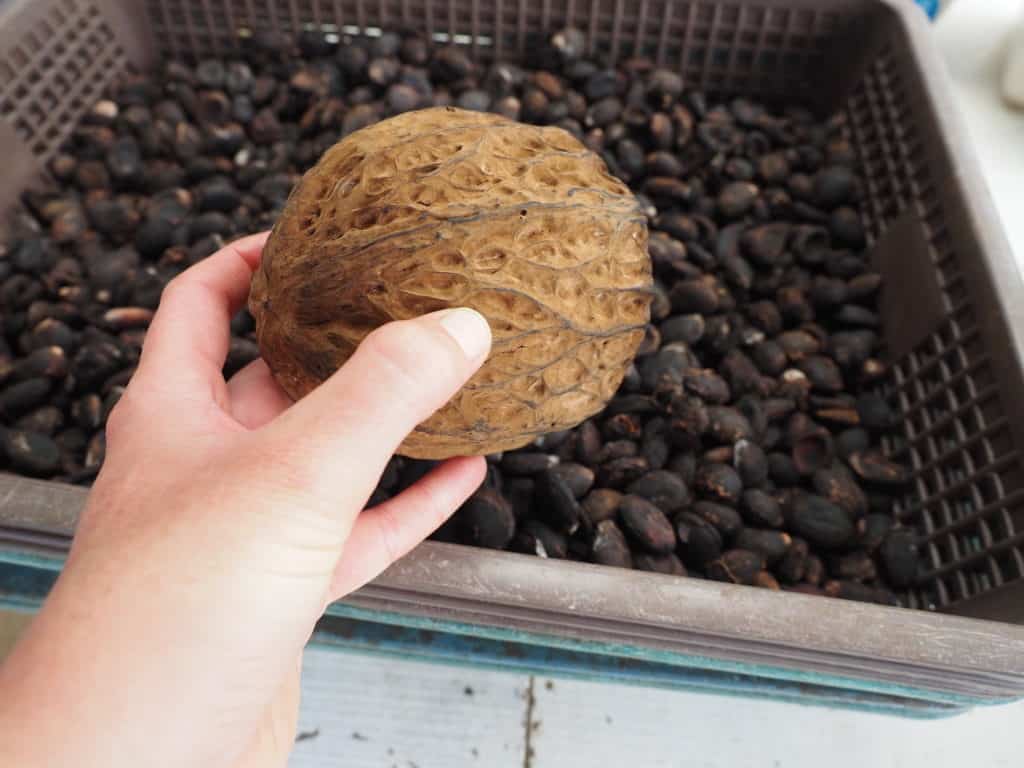
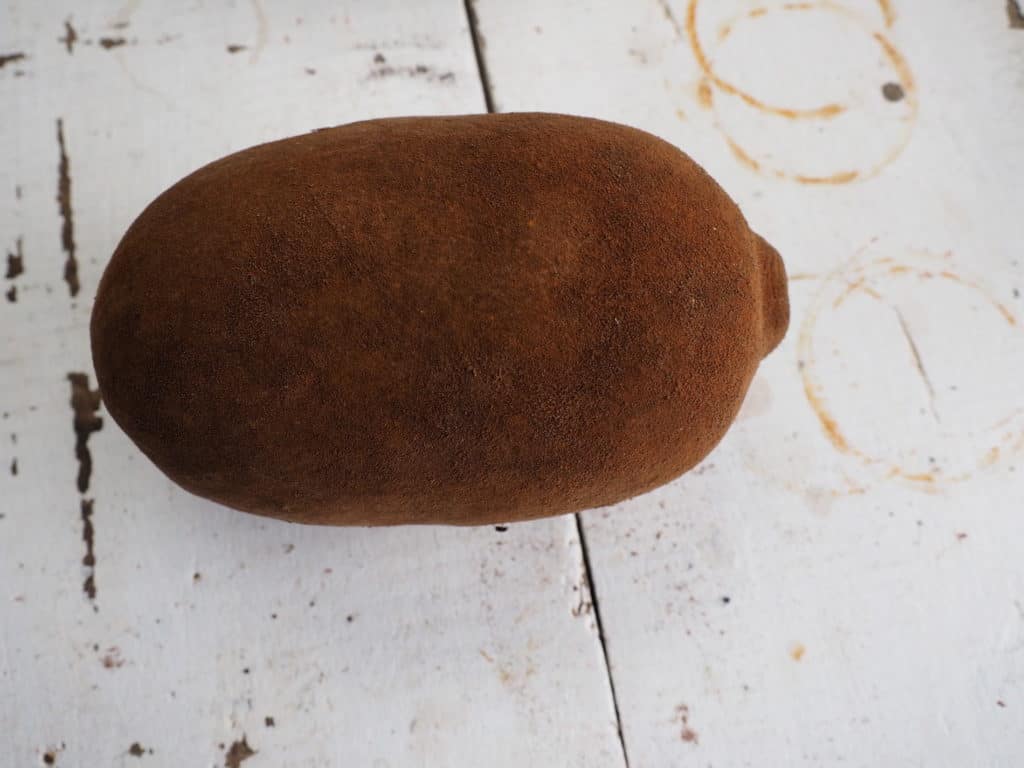
There’s also a small store on the property where you can buy aged goat cheese, pataxte and cupuazú chocolate, and noni juice (for the brave).
Don’t miss this off-the-beaten-track destination!
Tours available at Vivero Frutas del Mundo
Frutas del Mundo was founded by Dwight Carter, a former peace corps volunteer who’s lived in Guatemala since the 80s. He has a wealth of wisdom to share, plus a variety of facts, anecdotes, and results from his hobby experiments.
He gives educational walking tours to tourists, schools, agricultural students, fruit farmers, and any other visitors who have a hankering to visit.
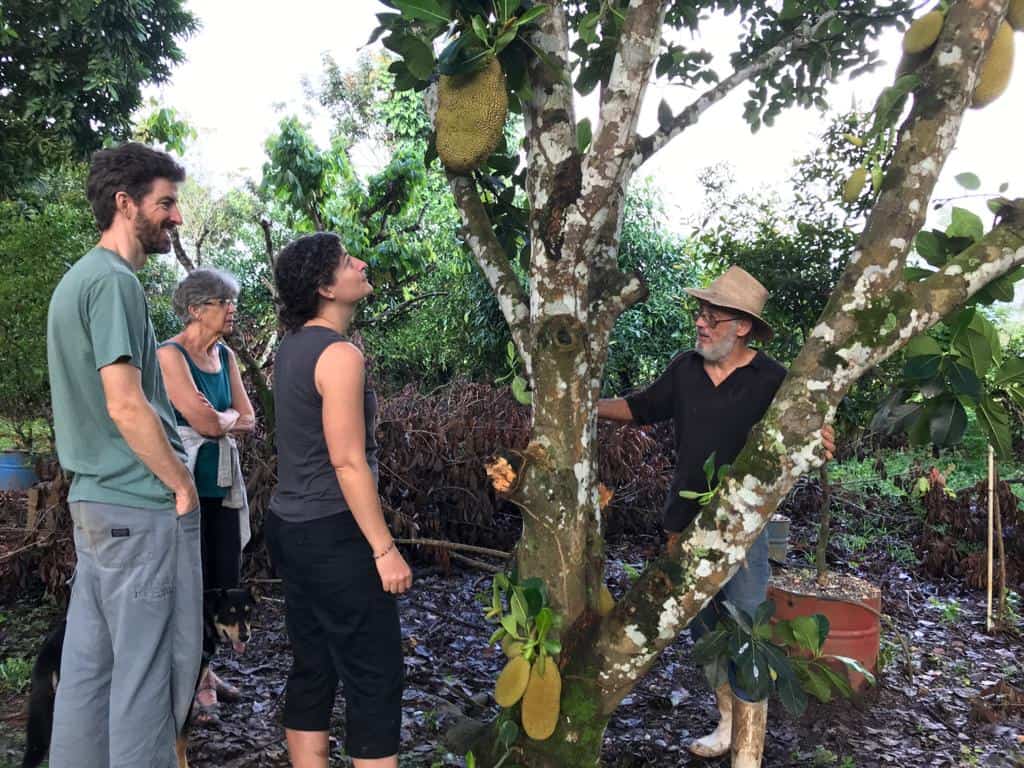
Dwight caters his tours to the interests of each group, so be sure to let him know ahead of time what topics and activities you would like to learn about the most. Tour topics can include:
- Exotic Fruit Varieties and tasting-testing
- Grafting (Dwight offers a 3-day grafting workshop)
- Nursery management
- Integrating animals/fish into agriculture
Farm-to-table Restaurant
If you opt to visit Vivero Frutas del Mundo, be sure to reserve a meal ahead of time at their farm-to-table restaurant. It’s a great way to upgrade your walking tour experiences. Plus, the prices are very reasonable.
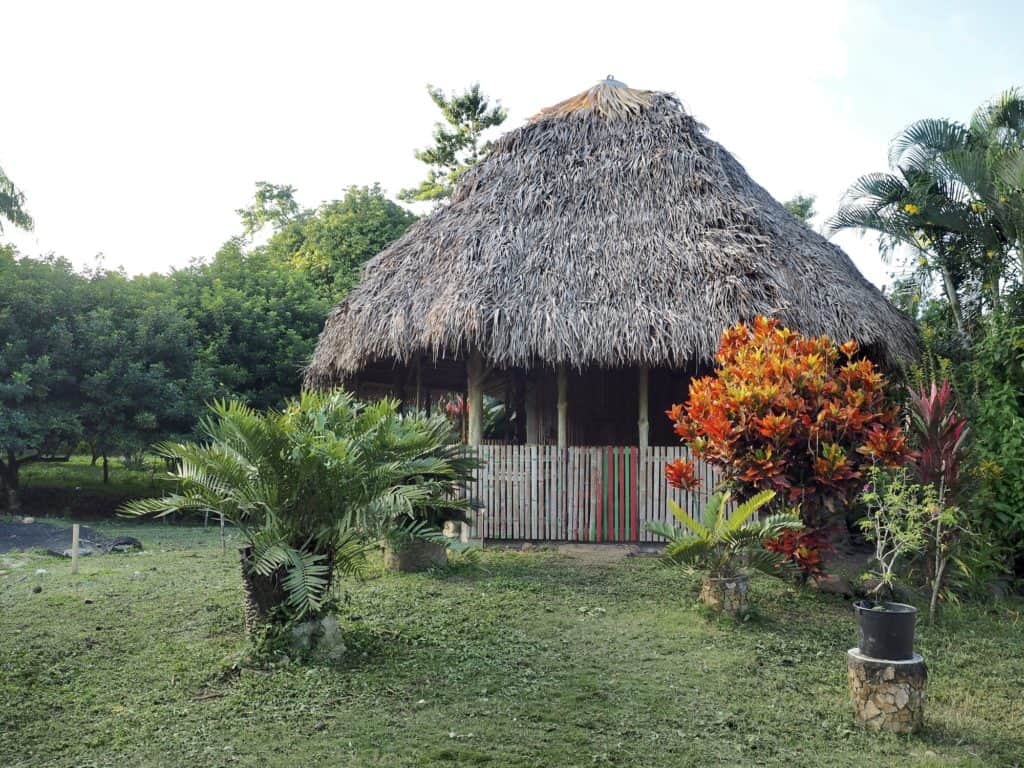
The restaurant serves a variety of delicious locally-grown vegetables and fruits. As an added bonus, they can cater to people with restricted diets and allergies. Gluten-free? Corn-free? No problem!
My family and friends really enjoyed our farm-to-table meal at Frutas del Mundo. We had tilapia wrapped in santa maria leaves, palm heart salad with lime and cilantro, Brazilian annona, star fruit, deep fried breadfruit wedges (my favorite), smoked chicken, traditional Guatemalan “caldo” (broth with veggies), rice, and to drink, a chilled star fruit “fresco.”
On other occasions, they may serve pulled jack fruit, other in-season fruits, and whatever else they dream up. If you aren’t salivating yet, you should be!
Exotic Fruit Tree Nursery
If you live in Guatemala, why not buy some exotic fruit trees for your backyard? The fruit trees sold at the nursery are primarily tropical, but some will do well at different climates and elevations. Dwight Carter can orient you as to which trees can grow well in your area.
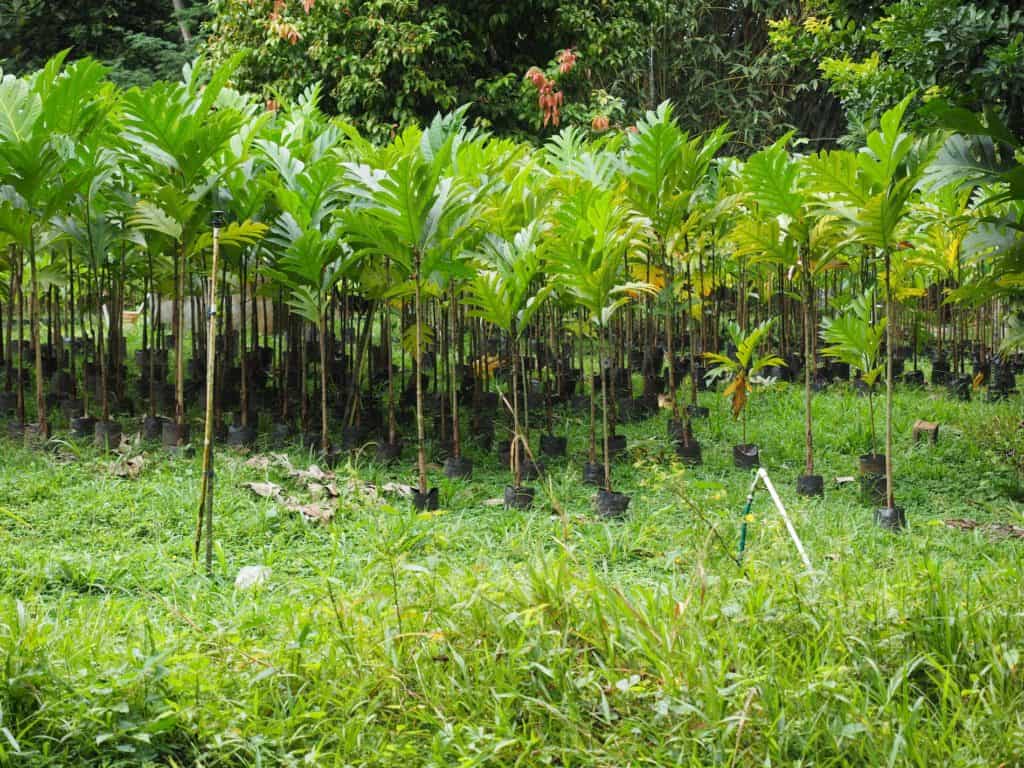
Check the list below to see what exotic fruit trees you can find (and possibly taste-test) at Vivero Frutas del Mundo.
Exotic Trees Available for Sale at Vivero Frutas del Mundo
This list isn’t exhaustive, but it’ll give you a good idea of the kinds of trees available for sale at Vivero Frutas del Mundo. Although it’s primarily a wholesale nursery, you can also buy smaller quantities of trees either at their farm or their retail location on CA-13.
Starfruit (Carambola)
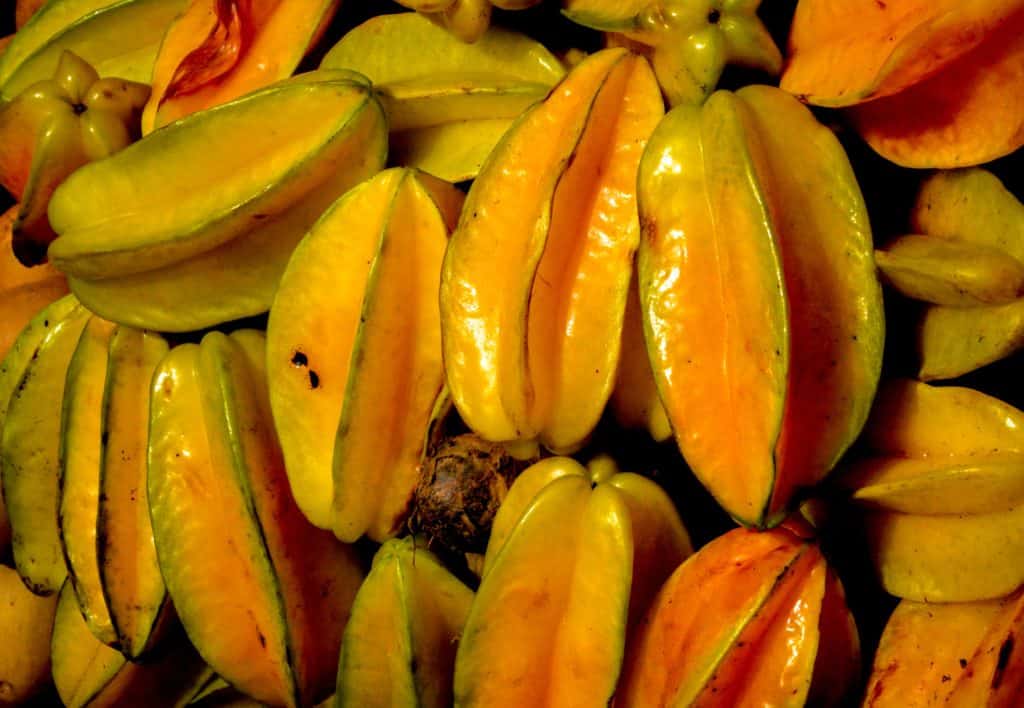
Carambola, or starfruit, is a delicious acidic fruit. When cut, the slices form lovely star shapes. Starfruit is delicious on its own, blended into an exotic lemonade-style beverage, or added to fruit salad. It also makes a great garnish on fancy drinks or fruit plates.
Nance
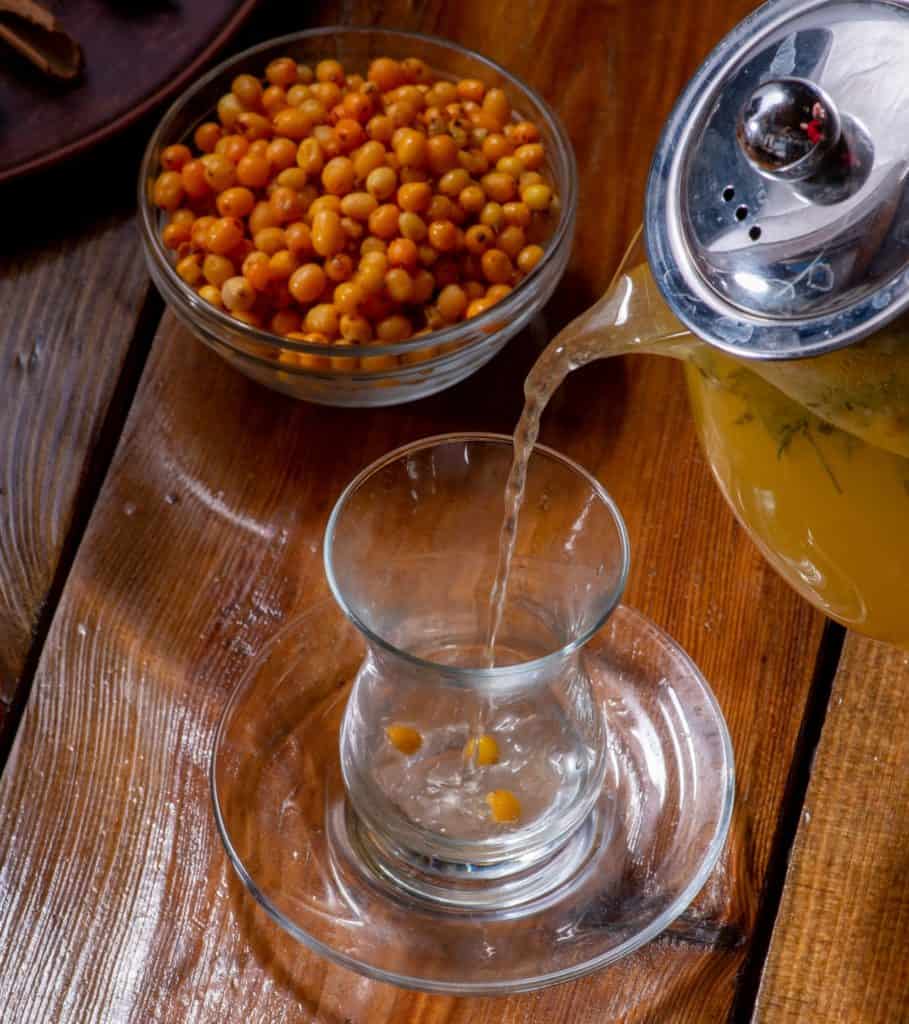
Nance is one of those fruits that you either love or hate. Nance fruits are small, oily, starchy, and astringent. To reduce the bitter flavor, soak the fruit in water for a day. My dad loves nance popsicles. You can also make them into jam or blend them into a refreshing drink.
Cinnamon (Canela)
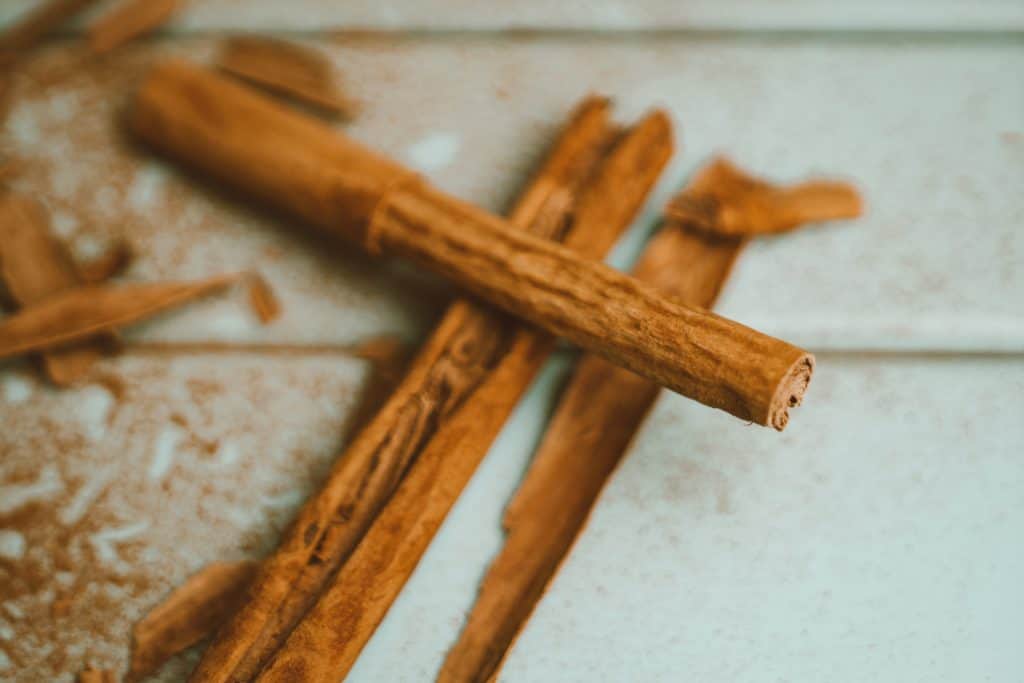
Want to grow your own cinnamon? If so, you can buy young trees at the nursery. Once the tree is two years old, cut it down to a stump and cover it with soil. It’ll grow back as a bush. Harvest the shoots, peel off the bark and let them dry into quills. Voila, you’ve got your first homegrown batch of this delicious warming spice.
Pear (Pera de Agua)
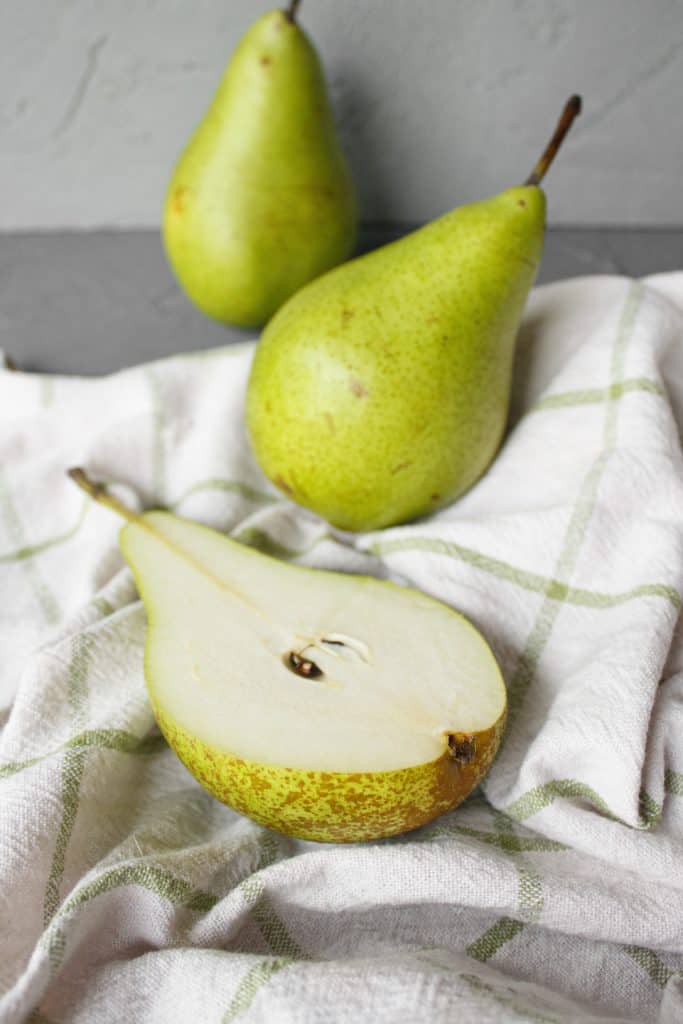
If you have a hankering for pears, you can purchase these trees at Frutas del Mundo as well. These pears have sweet white flesh. Yum.
Black Pepper (Pimienta Negra)
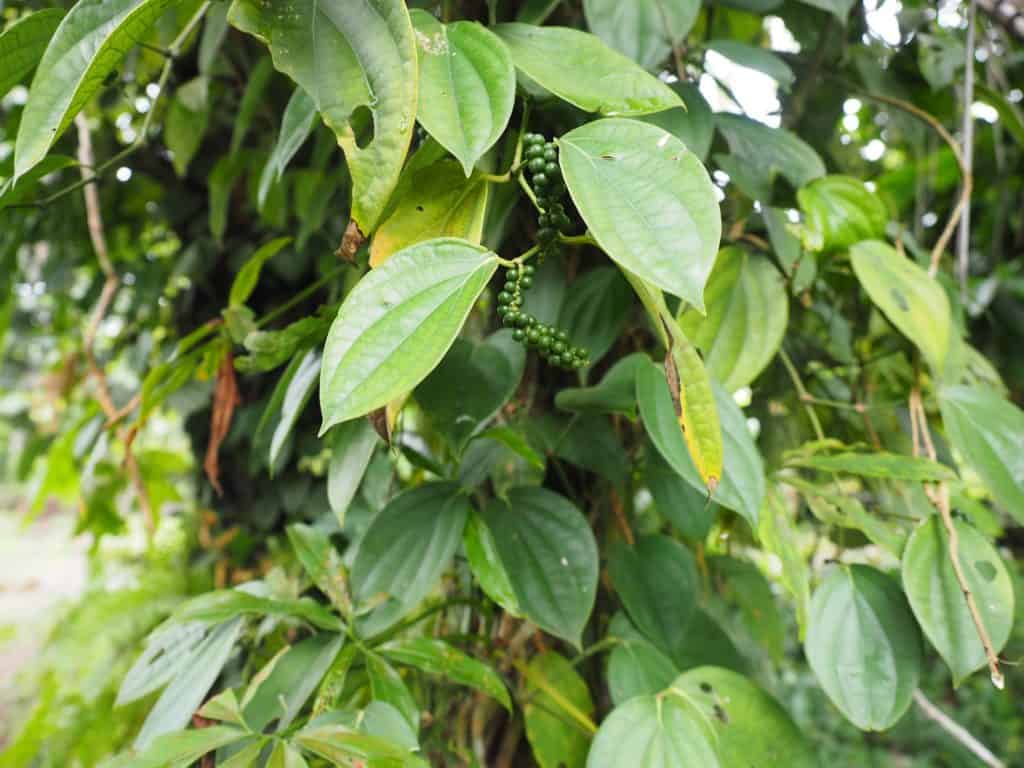
Black pepper is a tropical vine. If you want black peppercorns, harvest the pepper when the fruit is green, then let it dry. For red or white pepper, wait to harvest until the fruit ripens and turns red.
Calamondin Limes
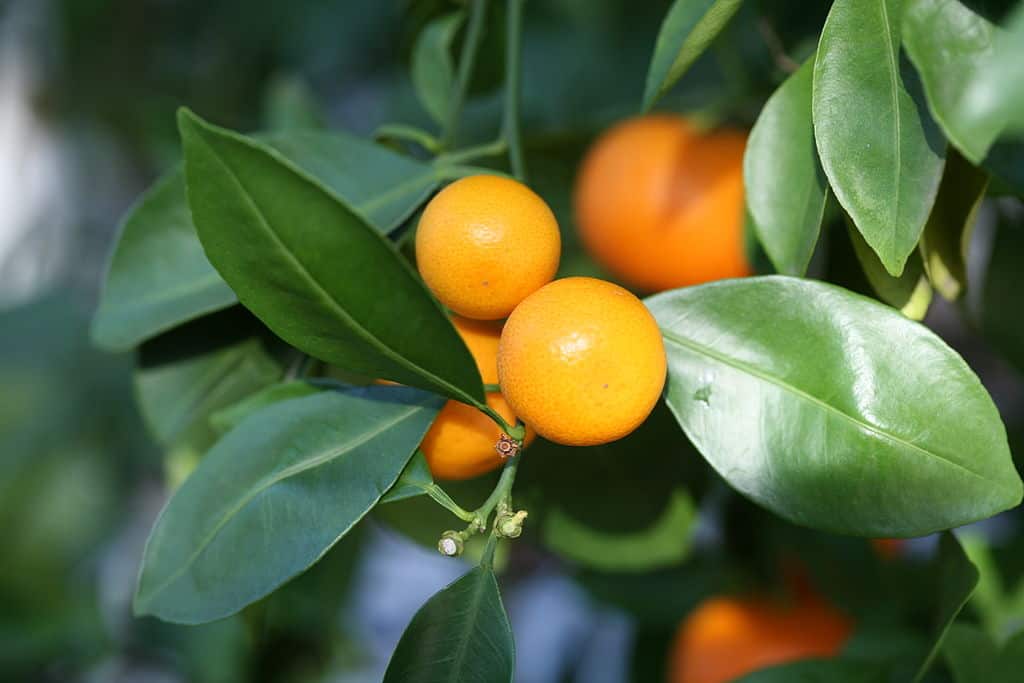
Calamondin limes are an interesting citrus fruit that you can eat whole (yup, peel and all!). These fruits make a fabulous marmalade. You can also use them raw to brighten up other foods, much as you’d use a regular lime.
Mango
Mangoes don’t need much explanation. These delicious tropical fruits are a great addition to fruit salad and smoothies, ice cream, fruity dressings, or dried and dipped in chocolate.
Achachairú
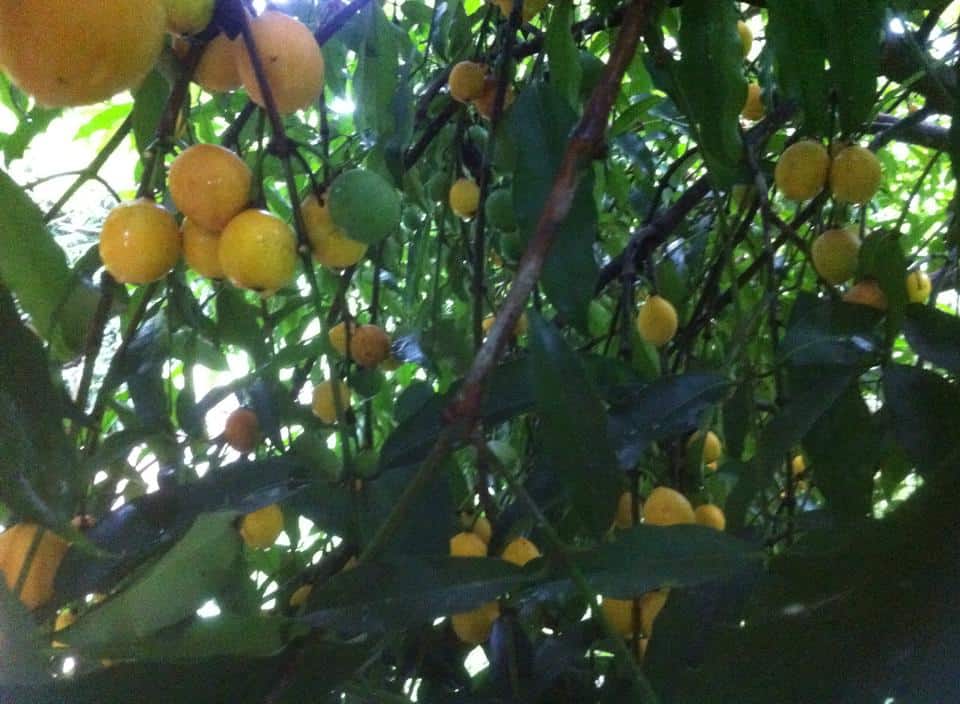
Achachairú is native to Bolivia and has a flavor Atlas Obscura describes as “sweet and moderately tart, with notes of mango, purple mangosteen, berries, and a dash of pepper.”
To eat this egg-shaped fruit, simply crack it open, then suck the white pulp off the seeds. Dry the rind and grind it to use as an acidic spice.
Mamey
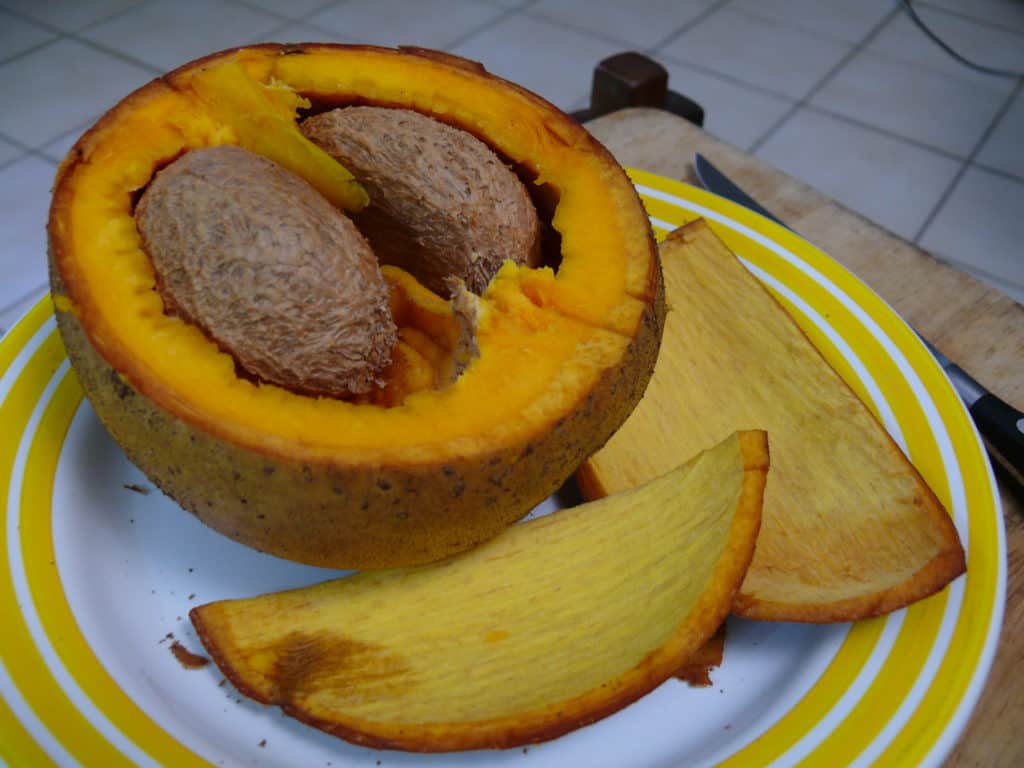
Mamey fruits are large and round with brown skin and bright yellow flesh. They are sweet and with floral notes.
Soursop (Guanaba)
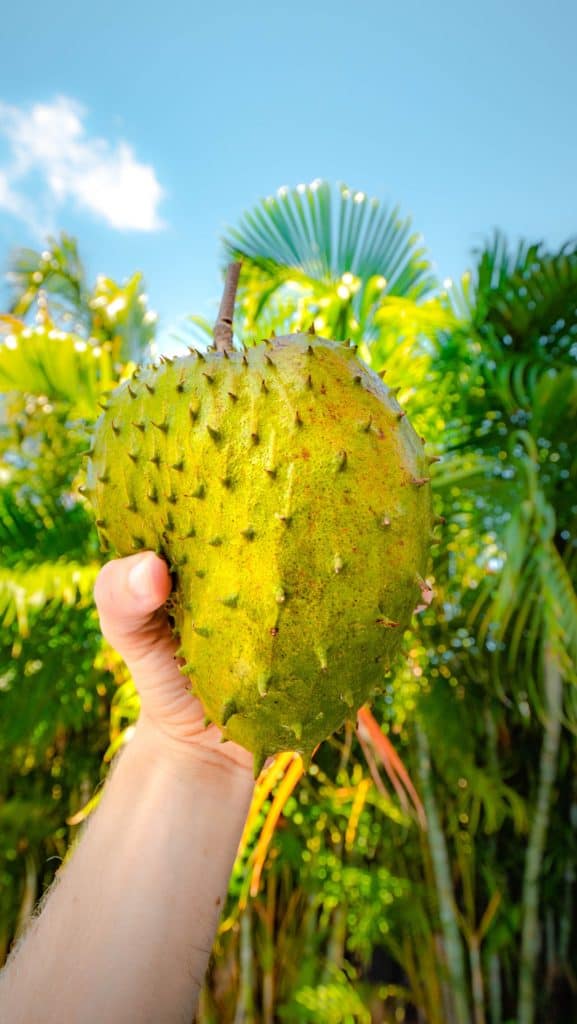
Soursop, known in Guatemala as Guanabana is a delicious white-fleshed fruit that looks a lot like an annona. If you’ve never tasted this fruit before, you’re in for a treat. Guanabana sherbert is one of my favorite flavors at Sarita’s ice cream shops.
Santol
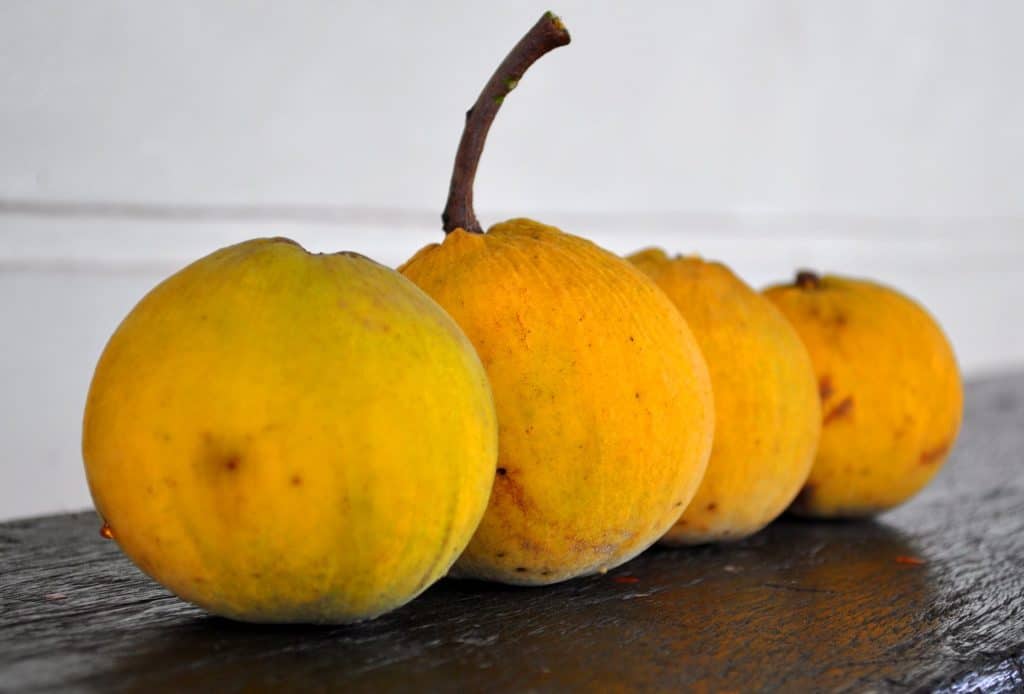
Santol is another exotic fruit with leathery brown skin and white slippery flesh. A single tree can produce up to 20,000 fruits in a year. According to Specialty Produce, “The sweetest Santol fruits have a candy-like taste with mild peach and apple notes, while in the sour varieties, a strong umami aftertaste may linger on the palate.”
Yellow and Purple Caimito (Caimito Amarillo o Morado)
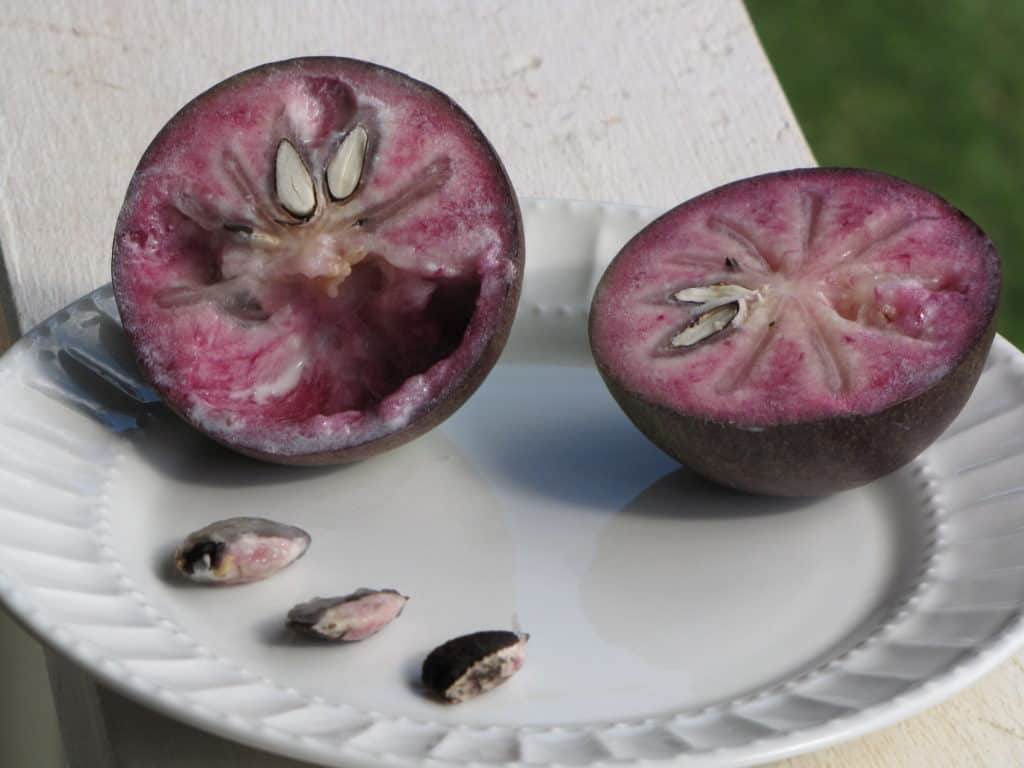
Caimitos, also known as star apples, are a sweet fruit native to both the West Indies and Central America. They have thick skin and either yellow or purple-tinged pulp. They must be picked by hand and are ready to eat when the outer skin is a bit wrinkled. Remove the seeds, then scoop out the pulp with a spoon.
Guava (Guayaba)
Guavas are a delicious sweet fruit with edible skin. They are great eaten raw, made into jam, or turned into “colocho” candies.
Cacao
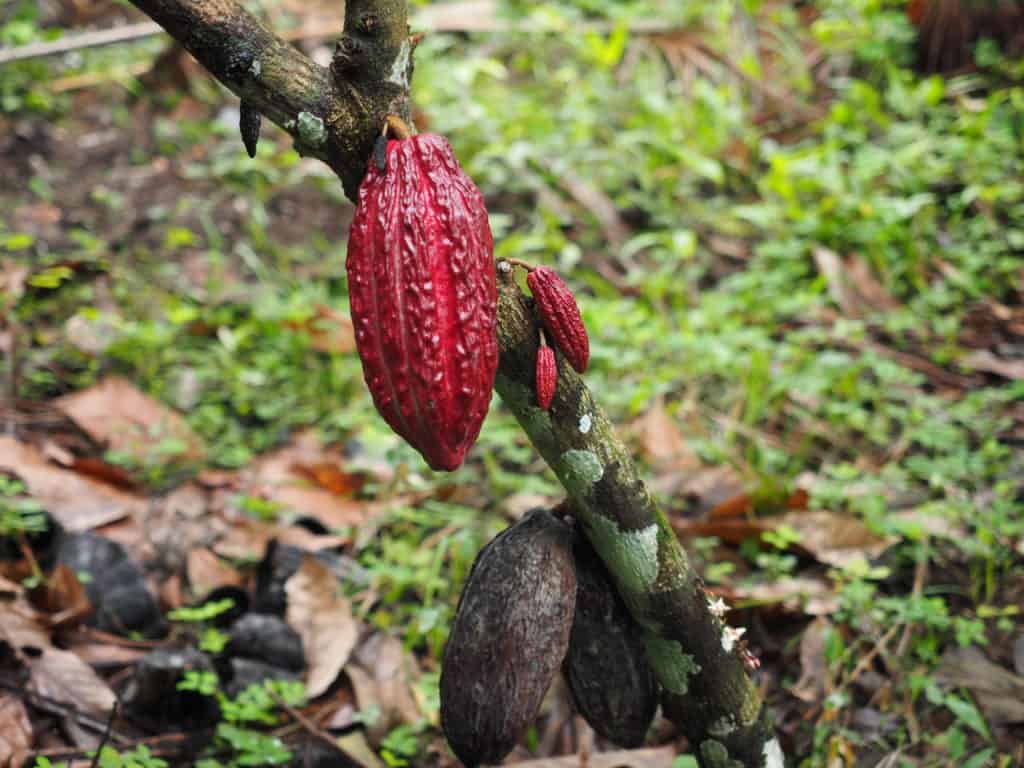
If you’ve ever wanted to make your own bean-to-bar chocolates, now’s your chance. Besides traditional chocolate (Theobroma Cacao), Dwight also grows lesser-known theobroma varieties on the property, including pataxte (theobroma bicolor) and cupuazú (theobroma grandiflora).
Chico Zapote
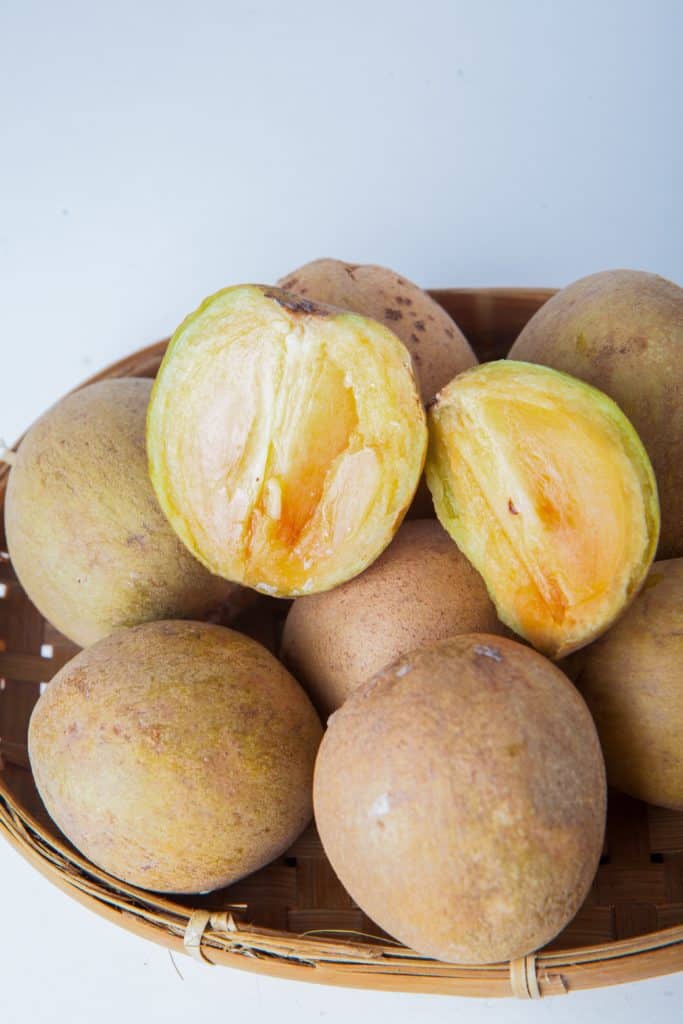
These trees produce a small fruit that has soft pear-like flesh. The tree also produces latex which was used to make the original chewing gum, “chicle.” If you take a tour, be sure to ask Dwight for the story behind chico zaapotes and chewing gum. Hint, it involves Santana, the Alamo, New York, and paraffin.
Zapote
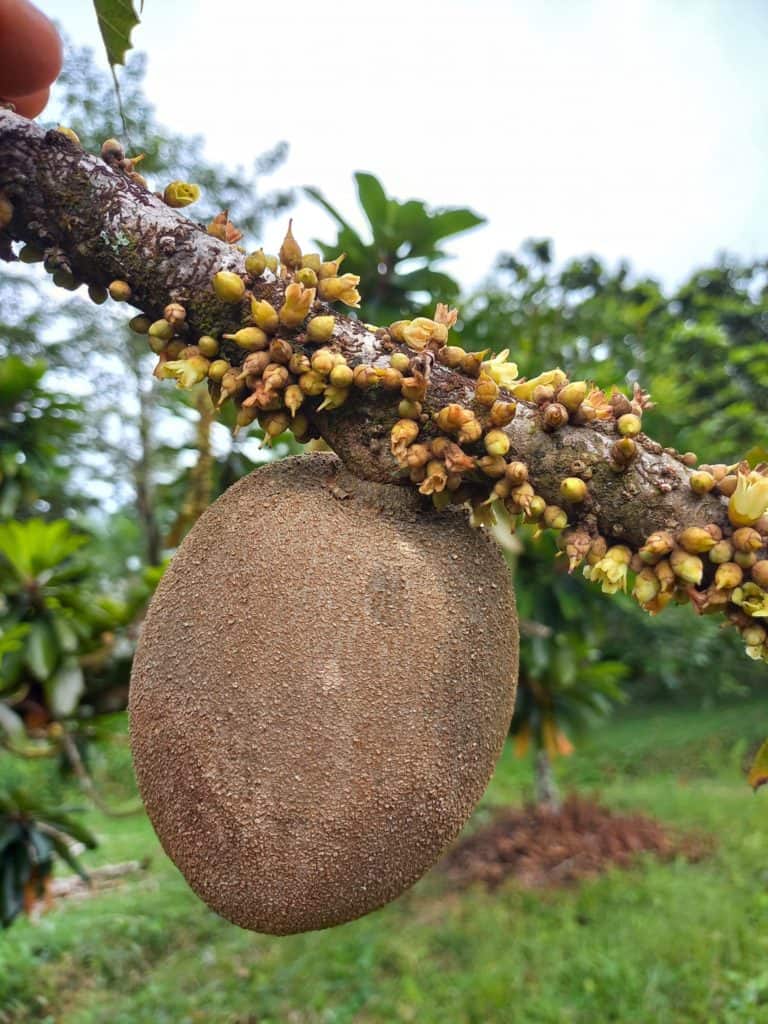
Zapote, also known as mamey zapote (pouteria sapota) are another yummy exotic fruit. If they are harvested at the appropriate time and ripened to perfection they taste sweet and creamy–the fruit version of flan.
To check for ripeness, scratch at the skin, if it is yellow or orange underneath, you can pick it. If it’s still green, leave it on the tree.
Miracle Fruit
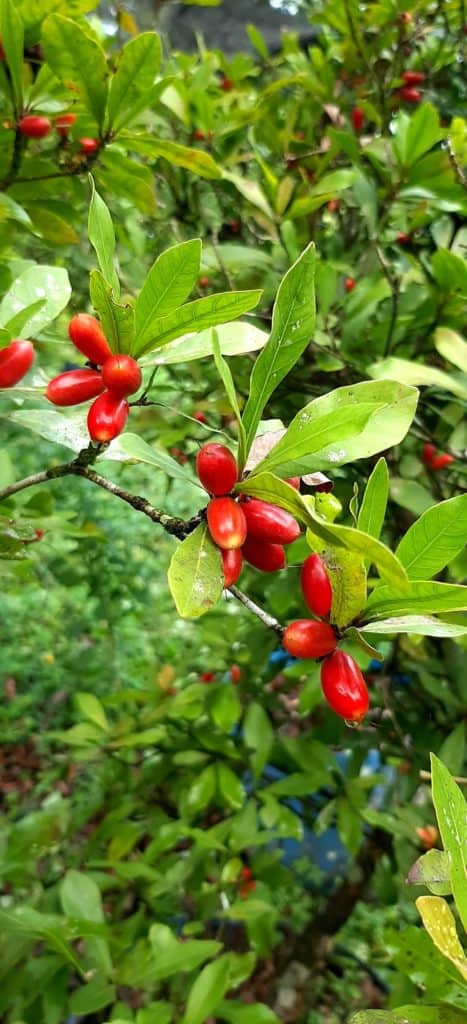
These funky fruits make the nerdy side of me happy. Miracle fruit tastes sweet but doesn’t contain much sugar. Instead, the sweetness comes from a glycoprotein called miraculin. Miraculin binds to your taste buds and makes anything sour you eat afterward taste sweet (at least until it gets washed away).
Have your friends over, give them a miracle fruit, then slice some limes and tell your friends to eat them. The effect will blow their minds.
Jocote
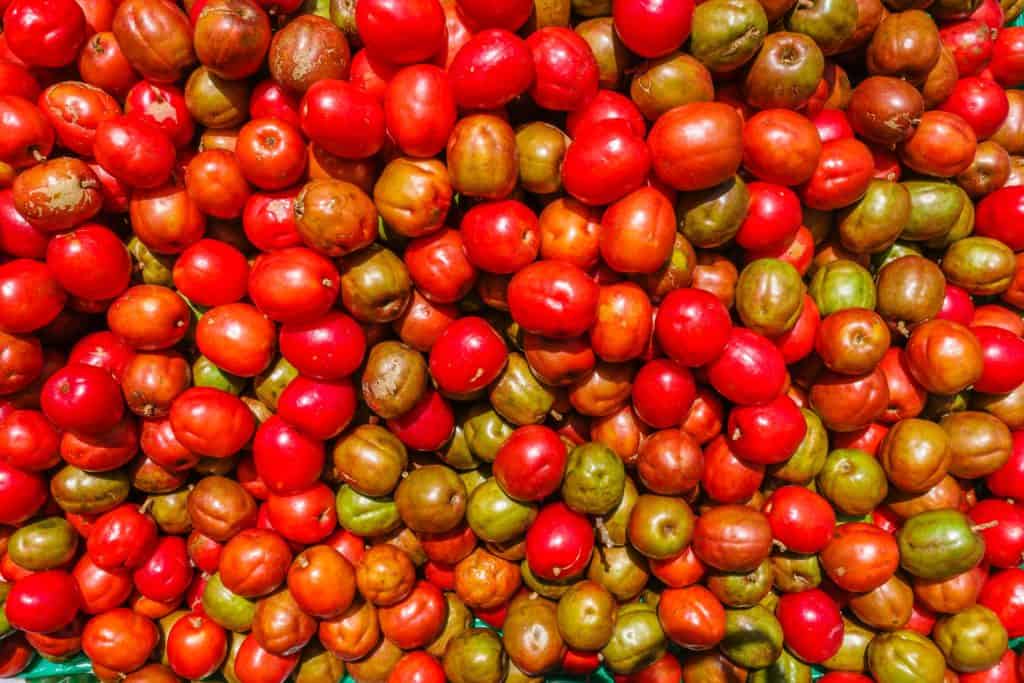
Jocote is a classic Guatemalan fruit with a big seed surrounded by soft yellow pulp and thin edible skin. The fruits grow from the branches of large deciduous trees.
Avocado
During our tour of the nursery, Dwight gave us even more reason to appreciate avocados. These trees can grow in a large range of climates and conditions and fruit and flower in the middle of the dry season.
Lanzon/Longkang
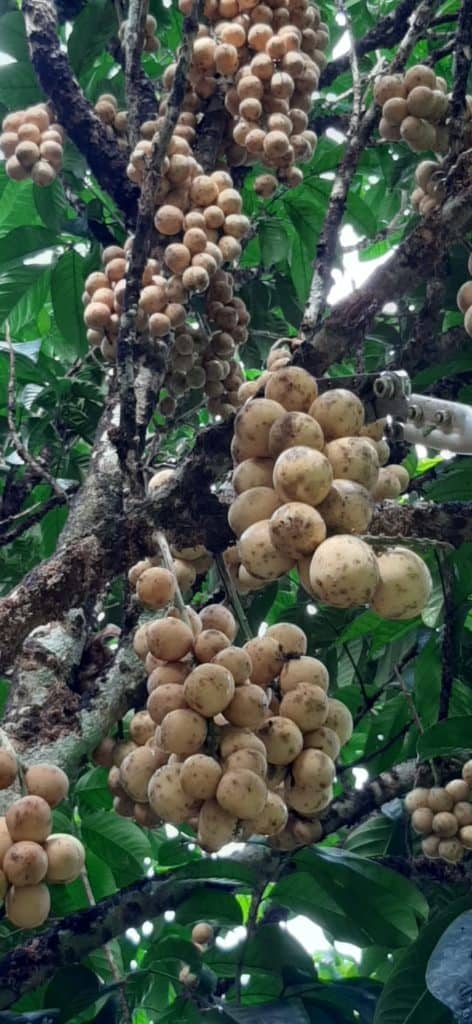
This Asian-native fruit resembles a potato, but the inside is a collection of translucent segments that can be either tart or sweet, much like a grape.
Jaboticaba
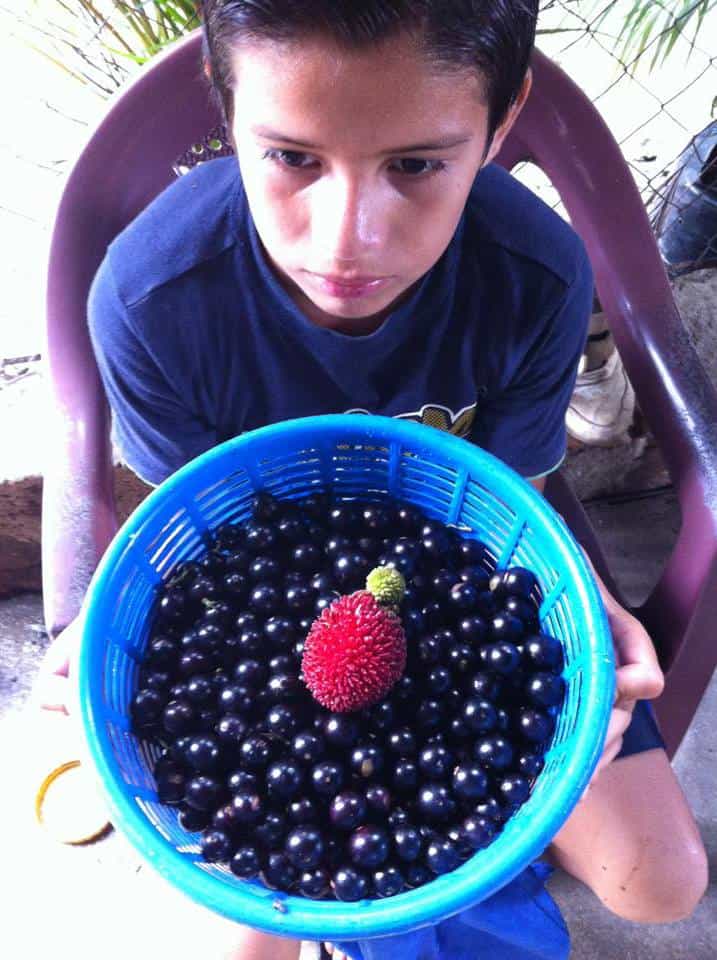
Grape-free wine, anyone? These strange trees produce a small purple fruit that grows directly from the trunk and branches. This tree is a native of Brazil and belongs to the myrtle family. You can eat jaboticaba fruit raw or turn it into wine or jelly.
Jackfruit (Jaca)
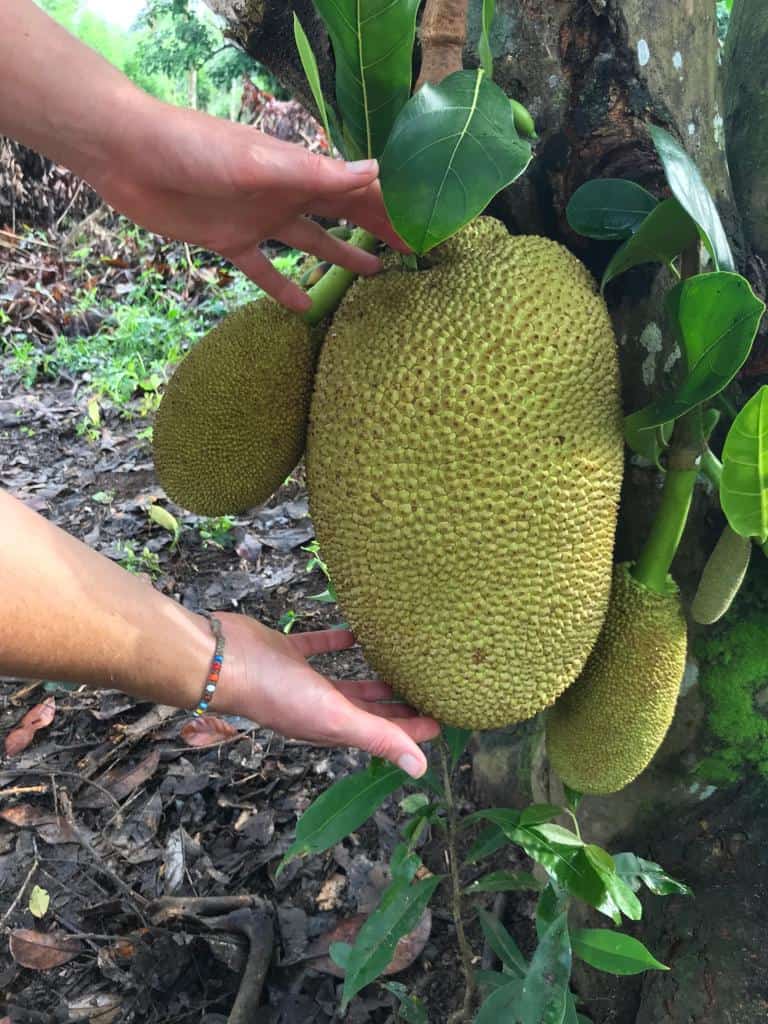
These enormous tropical fruits are a great way to feed a crowd. If you harvest them while they are still green, you can make savory dishes such as pulled jackfruit. At this stage, the taste and texture are similar to mushrooms. Alternatively, let the jackfruit ripen before butchering (be prepared for a lot of latex!). The ripe fruit tastes like a combination of bubblegum, apples, and bananas. The seeds can be peeled, boiled, and blended into a rich creamy dip.
Rambutan
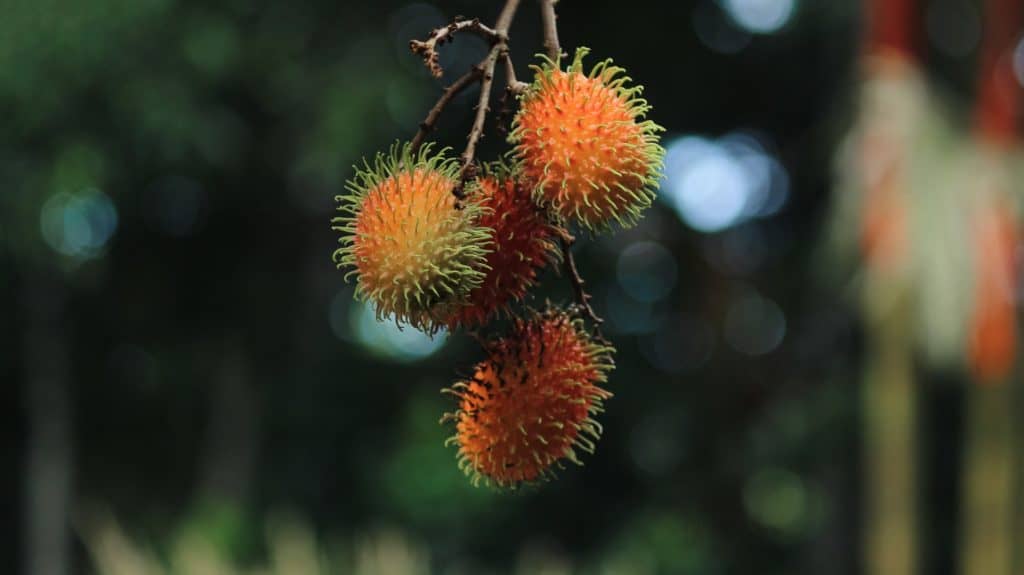
These hairy red fruits are sweet and delicious. They are great eaten raw or peeled and frozen for a cold tasty treat (just don’t swallow the seed).
Breadfruit (Masapan)
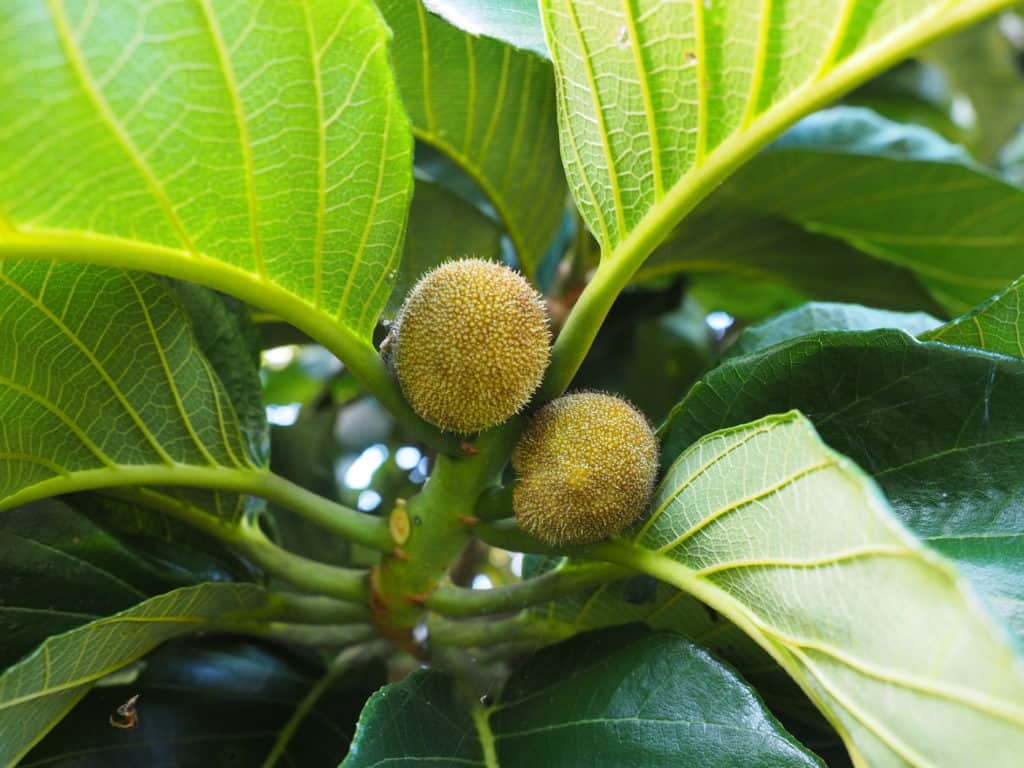
I fell in love with breadfruit during my trip to Izabal. These large starchy fruits are best eaten when still green and firm. Simply peel off the skin, cut out the core, and slice or chop. They are great deep-fried until golden and sprinkled with salt, sauteed with onions, or soaked, dried, and ground into flour for use in baking.
Lychee (Lichi)
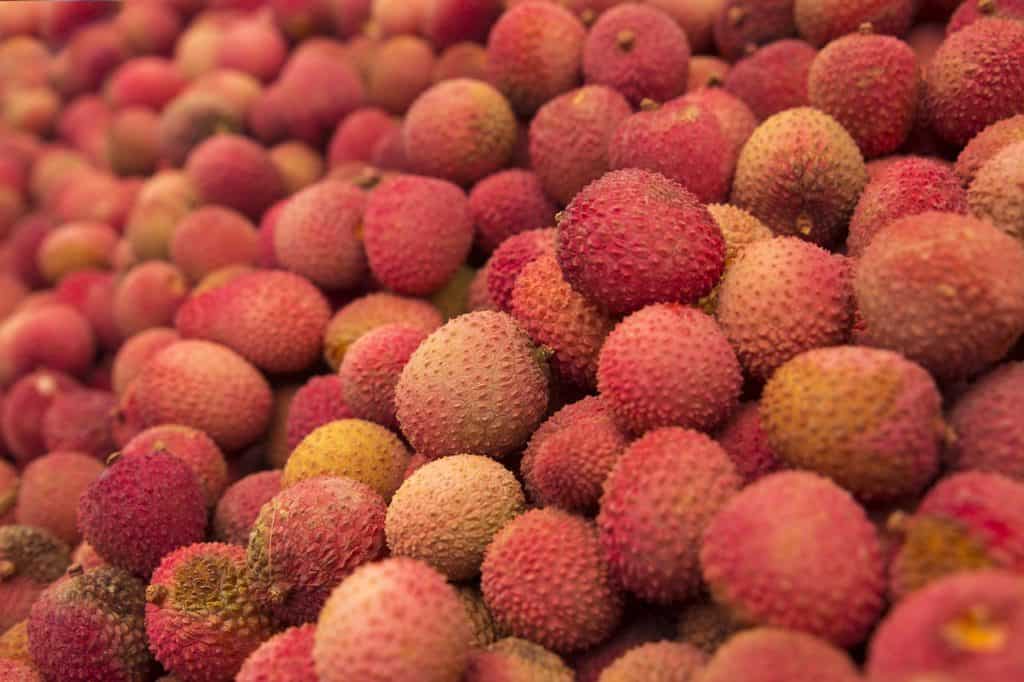
Similar to a rambutan, lychees have scaly pinkish or red skin. According to Specialty Produce, lychee “has a sweet and subtly acidic flavor with musky, floral, citrus, and rose water undertones combined with nuances of watermelon, strawberry, and melon.”
Longan
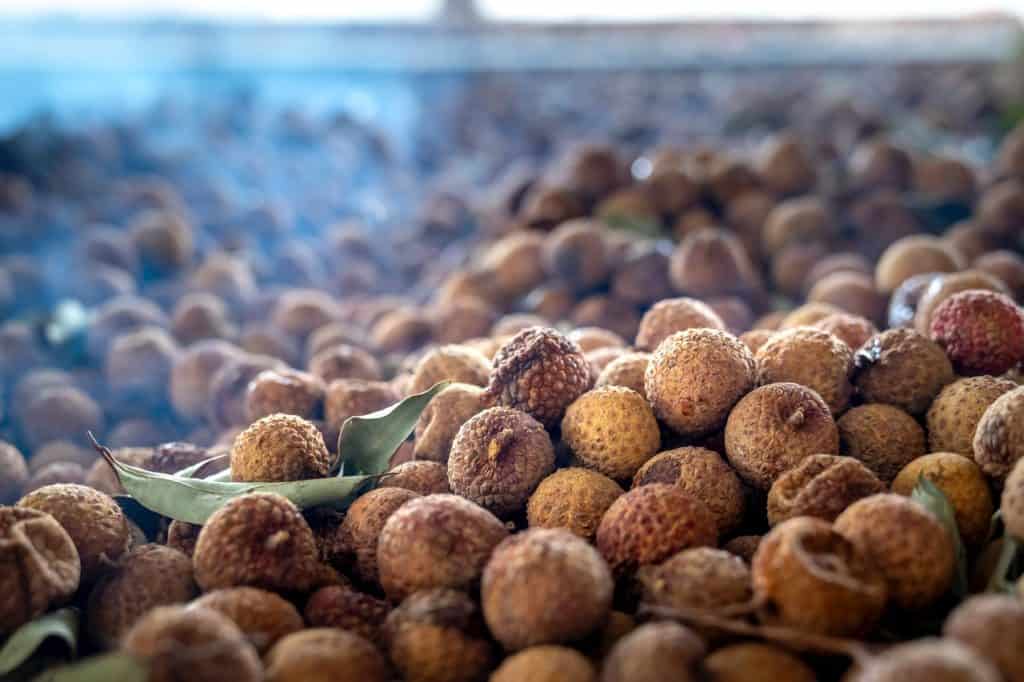
I’ve never eaten fresh longan, but a friend used to bring me bags of dried longans from Thailand… a delicious treat I still get a hankering for. These fruits are small with a sweet musky flavor that’s unforgettable.
Pulasan/Bulala
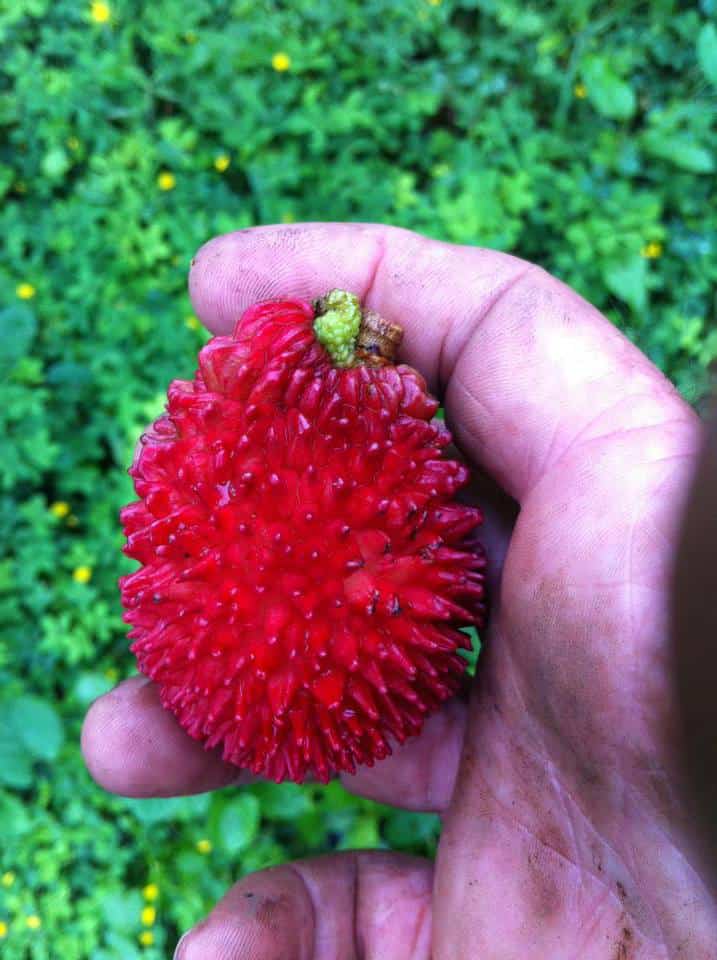
Pulasan fruit is in the same family as lychees and rambutans. They are so similar to the latter that it’s easy to confuse them. They have shorter and thicker hairs than rambutans. Unlike rambutans, the flesh separates from the seed, and the seed is edible.
Small and Large Mangosteens
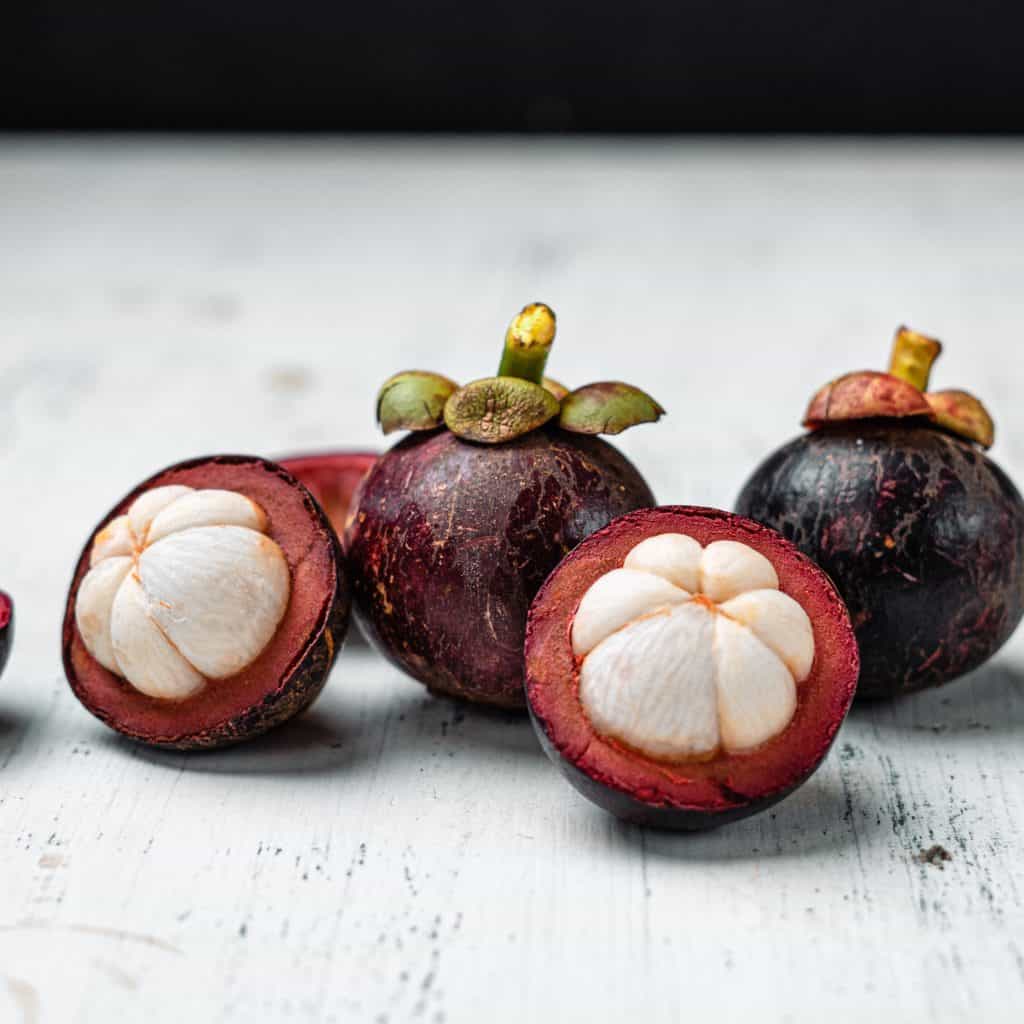
This tropical fruit has a thick skin and white segmented flesh. According to Specialty Produce, “Mangosteens offer a sweet-tart tropical flavor with notes of lychee, peach, strawberry, pineapple, and caramel or butter.” Curious yet? I know I am. I’ll have to keep an eye out for these in the market.
Durian
My roommate in college was the first to tell me about durian. She said that in Thailand, where she grew up, you couldn’t take durian on the bus because it smelled so strongly of stinky socks. She also said you had to eat it seven times before you liked the flavor. I guess I got lucky because I liked durian on the first try. The smell can be a bit overpowering, but the flavor is sweet, creamy, and fabulous.
Canistel
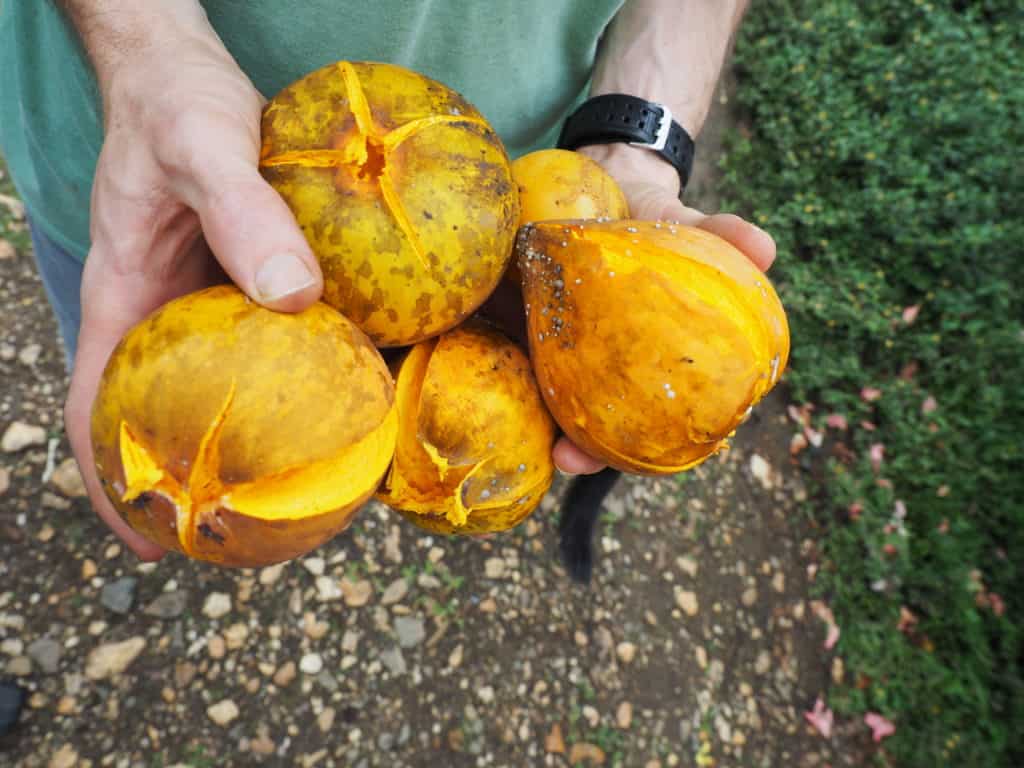
Canistels have the strangest texture of any fruit I’ve encountered to date. They are dry and crumbly… like a firm sweet potato or a hardboiled egg yolk. The flavor is sweet and tropical, and the color is brighter than a sunrise. My brother and I enjoyed eating these during the tour. Dwight said they make excellent ice cream and are also good in smoothies.
How to get to Vivero Frutas del Mundo
To get to Vivero Frutas del Mundo from Guatemala City, take CA-9 Norte towards Puerto Barrios. In Morales, turn north onto CA-13 towards Río Dulce. Turn left into the town of Buenos Aires, Izabal. Turn left at the first fork. Continue driving for two blocks, turn left, then one block later, turn right. Continue driving straight towards Aldea El Amatillo until you reach the Vivero Frutas del Mundo.
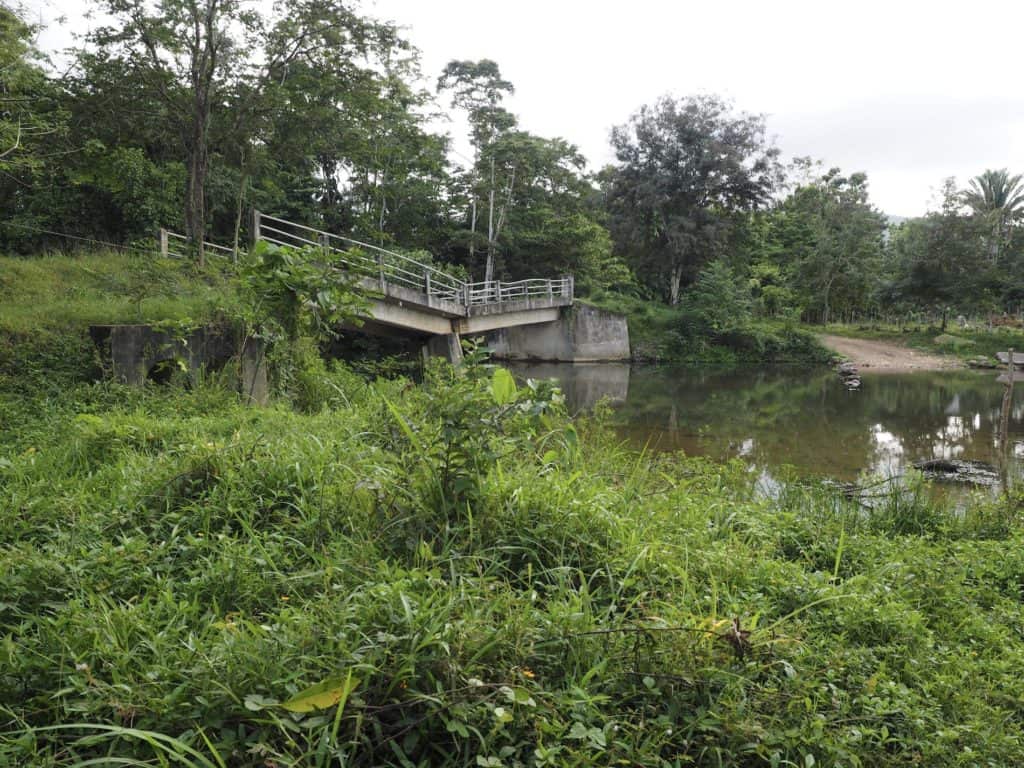
Note: The road can be quite muddy at certain points. There is also a broken bridge on the route (usable by motorcycles and pedestrians). However, if you’re coming in a car you will need to ford the river, or park your car somewhere nearby and walk the short distance to the nursery. Ask ahead to see how deep the river is.
Point of Interest: You will pass a large plantation of rubber trees. When I went, they were harvesting rubber from the trees.
Hours
Open 9:00 a.m. to 5:00 p.m. every day
Costs
Tour: Q25 per person
Farm-to-Table Meal: Q50 per person
Trees: variable
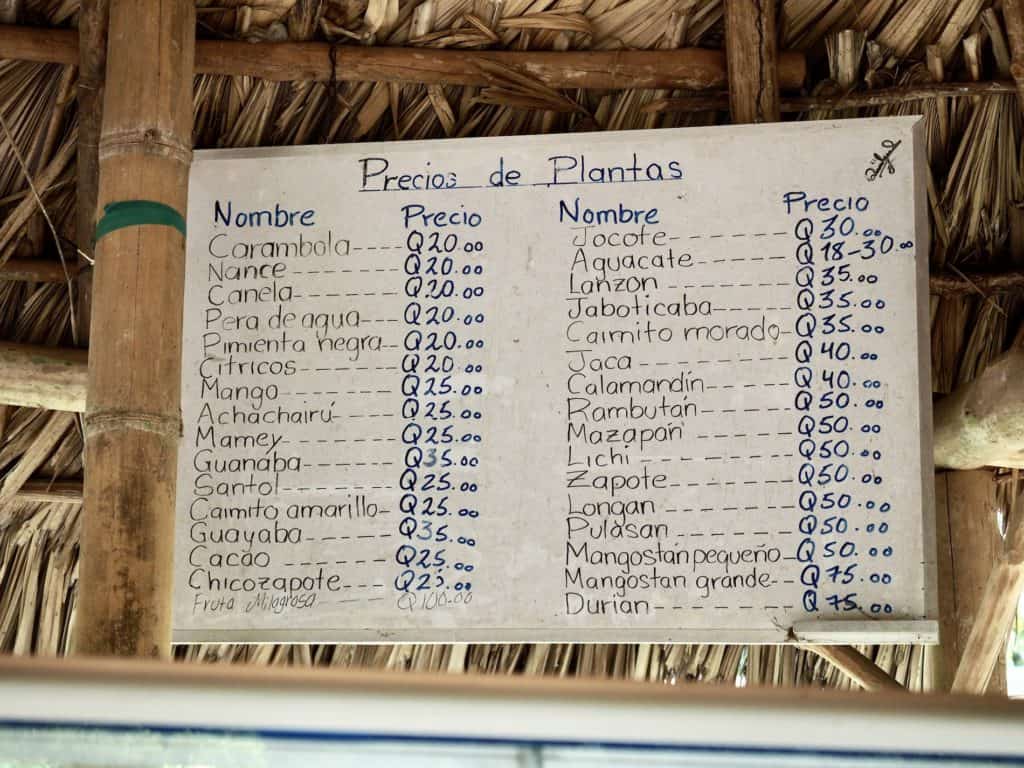
Contact Information for Vivero Frutas del Mundo
Telephone: +502 5208 6928
Email: [email protected]
Go to the Frutas del Mundo Facebook Page
What to take to Vivero Frutas del Mundo Izabal
- Rainjacket
- Insect Repellant
- Mud-resistant shoes
- Camera
Other sites to see near Vivero Frutas del Mundo
If you visit Vivero Frutas del Mundo, be sure to also check out the Castillo de San Felipe de Lara, only a 40 minute drive north. It’s also well worth making the hour and a half drive to visit the Cascadas el Paraíso and the El Boquerón Canyon.
***GUATEMALA TRAVEL PLANNING GUIDE***
Should I buy Guatemala travel insurance?
YES — Personally, I always travel with travel insurance because it gives me extra peace of mind. SafetyWing is an excellent travel insurance company that’s quite affordable. Plus, if you travel longterm, it’s a snap to renew on a month to month basis. You can keep renewing for up to a year and still pay the same deductible.
Where’s the best place for finding cheap flights to Guatemala?
When I purchase a ticket, I always search several different sites. Kayak and Expedia are great places to start running a search. Spirit is usually the cheapest carrier, but American Airlines and United also sometimes offer excellent deals.
What’s the best way to book my Guatemala accommodations?
I recommend booking.com for finding and booking hotels in Guatemala. For vacation rentals, I recommend VRBO.com — it offers beautiful and unique spots to stay.
What’s the best way to book Guatemala tours?
Viator is a great tour booking site with several excellent options available in Guatemala’s main tourist areas including Tikal, Atitlán, Antigua, and Acatenango. There’s a nice range of prices and options available.
Can you drink the water in Guatemala?
No – Don’t drink the tap water! Instead, buy purified water from any corner store or grocery store in Guatemala.
Be sure to brush your teeth with that water as well to avoid getting sick. And hydrated, especially when traveling to high elevations.
Do I need a visa for Guatemala?
Probably not — Visitors to Guatemala from “Category A” countries like the United States, Canada, the UK, New Zealand, Australia, and most European countries are automatically given a 90-day tourist visa (in the form of a passport stamp) when entering Guatemala.
This visa is valid for Guatemala, Nicaragua, Honduras, and El Salvador. At the end of 90 days, it can be renewed once at Guatemala’s Migración without leaving the country.
After 180 days, you will have to travel outside of Central America before returning. Check to see if you need a visa.
Will my phone work in Guatemala?
It’s possible, but check with your provider in advance to see if Guatemala is covered. If not, you can easily pick up a local SIM card.
There are essentially only two carriers in the country: TIGO and CLARO. Both have good coverage.
